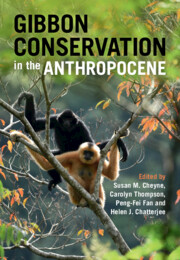Book contents
- Gibbon Conservation in the Anthropocene
- Gibbon Conservation in the Anthropocene
- Copyright page
- Contents
- Contributors
- Foreword
- Abbreviations
- Introduction
- 1 Taxonomy, Ecology and Conservation of Cao Vit Gibbon (Nomascus nasutus) since Its Rediscovery
- 2 Conservation Status of the Northern Yellow-Cheeked Crested Gibbon (Nomascus annamensis) in Vietnam
- 3 Strategies for Recovery of the Hainan Gibbon (Nomascus hainanus)
- 4 Gibbons in the Anthropocene
- 5 Demography of a Stable Gibbon Population in High-Elevation Forest on Java
- 6 A Tale of Two Gibbon Studies in Thailand
- 7 Accessibility as a Factor for Selecting Conservation Actions for Pileated Gibbons (Hylobates pileatus)
- 8 Calling from the Wild
- 9 Demography and Group Dynamics of Western Hoolock Gibbons (Hoolock hoolock) in a Community Conserved Village Population in Upper Assam, India
- 10 Challenges and Prospects in the Conservation of Hoolock Gibbon in India
- 11 Gibbons of Assam
- 12 Movement Ecology of Siamang in a Degraded Dipterocarp Forest
- 13 Sympatric Gibbons in Historically Logged Forest in North Sumatra, Indonesia
- 14 Adopting an Interdisciplinary Biosocial Approach to Determine the Conservation Implications of the Human–Gibbon Interface
- 15 Listen to the People, Hear the Gibbons Sing
- 16 Long-Term Outcomes of Positive Cultural Value for Biodiversity
- 17 Gibbon Phylogenetics and Genomics
- 18 The Use of Microsatellites in the Management of Captive Gibbons
- Index
- References
14 - Adopting an Interdisciplinary Biosocial Approach to Determine the Conservation Implications of the Human–Gibbon Interface
A Systematic Review
Published online by Cambridge University Press: 13 April 2023
- Gibbon Conservation in the Anthropocene
- Gibbon Conservation in the Anthropocene
- Copyright page
- Contents
- Contributors
- Foreword
- Abbreviations
- Introduction
- 1 Taxonomy, Ecology and Conservation of Cao Vit Gibbon (Nomascus nasutus) since Its Rediscovery
- 2 Conservation Status of the Northern Yellow-Cheeked Crested Gibbon (Nomascus annamensis) in Vietnam
- 3 Strategies for Recovery of the Hainan Gibbon (Nomascus hainanus)
- 4 Gibbons in the Anthropocene
- 5 Demography of a Stable Gibbon Population in High-Elevation Forest on Java
- 6 A Tale of Two Gibbon Studies in Thailand
- 7 Accessibility as a Factor for Selecting Conservation Actions for Pileated Gibbons (Hylobates pileatus)
- 8 Calling from the Wild
- 9 Demography and Group Dynamics of Western Hoolock Gibbons (Hoolock hoolock) in a Community Conserved Village Population in Upper Assam, India
- 10 Challenges and Prospects in the Conservation of Hoolock Gibbon in India
- 11 Gibbons of Assam
- 12 Movement Ecology of Siamang in a Degraded Dipterocarp Forest
- 13 Sympatric Gibbons in Historically Logged Forest in North Sumatra, Indonesia
- 14 Adopting an Interdisciplinary Biosocial Approach to Determine the Conservation Implications of the Human–Gibbon Interface
- 15 Listen to the People, Hear the Gibbons Sing
- 16 Long-Term Outcomes of Positive Cultural Value for Biodiversity
- 17 Gibbon Phylogenetics and Genomics
- 18 The Use of Microsatellites in the Management of Captive Gibbons
- Index
- References
Summary
The gibbons (family Hylobatidae) represent one of world’s most threatened group of taxa. In theory they are an attractive group for interdisciplinary research but are often unconsciously overlooked. We conducted a systematic review in Web of Science and Google Scholar between January 1900 and February 2020 using PRISMA guidelines and strict search criteria to investigate (1) the number of mixed-method biosocial studies published on gibbons; (2) focus species and countries; (3) social analytical approaches used; and (4) the success of this approach in elucidating conservation issues. Only 31 mixed-method biosocial studies have been published on gibbons, 56 per cent on Nomascus species but none on Symphalangus. China and Vietnam were the most popular study locations. Optimistically, 68 per cent of publications were led by gibbon-range country researchers, but only 48 per cent of studies represented international collaborations; 81 per cent of studies addressed a conservation-related topic, highlighting the potential efficacy of using this approach in primate conservation research. However, few studies provided details of data collection methods, methods of analysis and sample sizes, and only one study used an anthropological analytical approach. We therefore encourage further cross-disciplinary international collaborations to better our understanding of human–gibbon relations on a deeper, more contextual level.
Keywords
- Type
- Chapter
- Information
- Gibbon Conservation in the Anthropocene , pp. 224 - 252Publisher: Cambridge University PressPrint publication year: 2023

